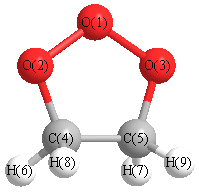Vibrational Frequencies calculated at CCSD/TZVP
| Mode Number |
Symmetry |
Frequency
(cm-1) |
Scaled Frequency
(cm-1) |
IR Intensities
(km mol-1) |
Raman Act
(Å4/u) |
Dep P |
Dep U |
|---|
| 1 |
A' |
3185 |
3040 |
28.36 |
|
|
|
| 2 |
A' |
3107 |
2965 |
45.52 |
|
|
|
| 3 |
A' |
1554 |
1483 |
0.24 |
|
|
|
| 4 |
A' |
1392 |
1329 |
0.38 |
|
|
|
| 5 |
A' |
1274 |
1216 |
1.42 |
|
|
|
| 6 |
A' |
1047 |
999 |
33.65 |
|
|
|
| 7 |
A' |
967 |
923 |
13.31 |
|
|
|
| 8 |
A' |
929 |
887 |
4.41 |
|
|
|
| 9 |
A' |
880 |
840 |
1.03 |
|
|
|
| 10 |
A' |
721 |
688 |
2.05 |
|
|
|
| 11 |
A' |
422 |
402 |
4.34 |
|
|
|
| 12 |
A" |
3168 |
3023 |
0.60 |
|
|
|
| 13 |
A" |
3097 |
2956 |
22.95 |
|
|
|
| 14 |
A" |
1535 |
1465 |
0.31 |
|
|
|
| 15 |
A" |
1383 |
1320 |
0.96 |
|
|
|
| 16 |
A" |
1240 |
1184 |
0.00 |
|
|
|
| 17 |
A" |
1187 |
1133 |
0.00 |
|
|
|
| 18 |
A" |
1058 |
1010 |
2.77 |
|
|
|
| 19 |
A" |
802 |
765 |
31.97 |
|
|
|
| 20 |
A" |
737 |
704 |
2.45 |
|
|
|
| 21 |
A" |
126 |
120 |
3.63 |
|
|
|
Unscaled Zero Point Vibrational Energy (zpe) 14904.8 cm
-1
Scaled (by 0.9544) Zero Point Vibrational Energy (zpe) 14225.2 cm
-1
See section
III.C.1 List or set vibrational scaling factors
to change the scale factors used here.
See section
III.C.2
Calculate a vibrational scaling factor for a given set of molecules
to determine the least squares best scaling factor.
